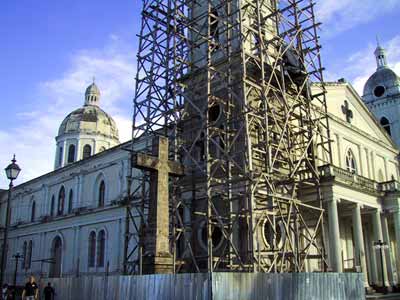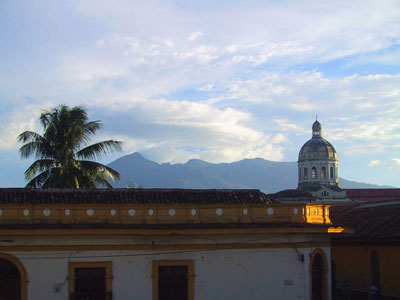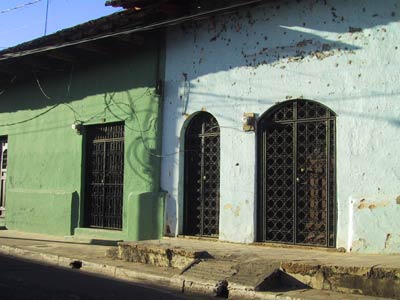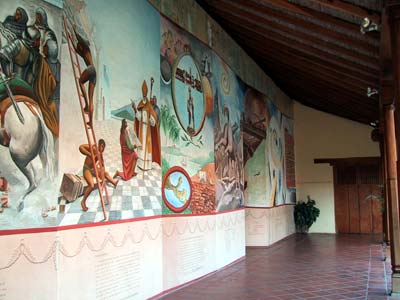Style & Charm in Granada, Nicaragua
Think of Granada and the Spanish city might come to mind: rolling hills, sangria, tapas and other Andalusian details. But to focus on that place would be to neglect another gem with its own culture and landscape, Granada, Nicaragua. Founded in 1524 by Spanish explorer Hernandez de Cordoba, Granada was named for the first city (his hometown), and a lot of the style and charm evident here has to do with its international inheritance. Even its nickname, la Gran Sultana has been passed down from Spain and its Arabian influence. Granada is the oldest colonial city in Central America and has developed a stately flair that you won't find in any of the nearby towns.

The unique character is seeped into the architecture, the geography, geology, history and culture. These are the quotients of any city but in Granada they meld and complement and come up with something completely different. Part of this influence is Spanish—the atmosphere here is distinctly European with its stoic, pillared homes and huge stone cathedral, but the rest can only belong to Nicaragua—volcano views that surround the town, beautifully coloured buildings lush green palms and ferns, and charming Nicaraguan people. Coming into Granada from the poverty and dust of Nicaragua, Granada feels dignified and distinguished. It is a grand old city, full of character and stories that you can see played out in the streets and the architecture. Everything meshes together to give a sense of pride to culture and history and you can tell immediately that something else is going on here. This place has style.
Granada was built near the water, like most important outposts of the day, but it is unique in that it is actually on the shores of Lake Nicaragua (the second largest Lake in Latin America) and not on one of the nearby oceans. This was a strategic location for the city. Granada sits on the northwest shore of the lake, slightly south of the capital city, Managua. The Pacific Ocean is only 18km away overland, and the Caribbean Sea is accessible via the lake and the San Juan River. This way the city had a tight grasp on commerce through the area for hundreds of years, and more recently was even considered for the site of the Panama Canal. The lake takes up a big chunk of Nicaragua and creates a lot of fertile areas for farming. It's now believed that the lake was actually once part of the Pacific Ocean and got landlocked through a series of volcanic eruptions. This seems likely considering that the lake is the only place in the world where fresh-water sharks exist, as well as a number of birds and creatures normally found near the sea!

Our trip to Granada started in Costa Rica. My girlfriend and I decided to venture into Nicaragua on a bit of a spontaneous detour. We hadn't initially planned to go there, but were lured by the prospect of another stamp in our passports (in fact we got four!) and we were rewarded in so many other ways. The land of lakes and volcanoes, as Nicaragua is aptly named, is beautiful countryside and the people were warm and welcoming. We came up from Costa Rican border, stopping first to look at the Concepcion y Maria volcanoes emerging from the centre of Lake Nicaragua, and then up to the top of the Santiago volcano for a look inside. It was interesting, and I learned a lot, but it was nothing compared with arriving in the streets of Granada.
We disembarked in the centre of the plaza, right in front of the cathedral and started to get a feel for the town. It's striking. The cathedral dominates, although it is less ornate than most Spanish undertakings—all white stone and few frills, but what it lacks in gilt, it makes up in size. I'm not sure what the inside capacity was like, as we didn't go inside, but I'm sure it is immense. Instead took a hot walk around the square. It was noon and everyone was just going about their day: children were playing, adults were lounging on park benches and veranda rocking chairs enjoying the shade, young girls were selling ice cream and jewelry. Everyone was spending a very content afternoon. The pace was set partly from the heat, but even still, Granada seemed to have distanced itself from the frantic scrambling of tourists and the beggars that inevitably follow them. There were a few of both, to be sure, but they somehow got lost in the charm of the city. The plaza lolls in front of the cathedral, a huge amount of space, which is typical of any Latin city. The church and plaza (marketplace) are always at the centre and various shops, services and homes extending outward from there. It reflects the values of the people, with the church and economy as pillars and everything else related spatially in order of importance. In Granada, the view from the cathedral steps is particularly delightful; great old colonial homes and stately hotels line up together in all different colours. There are various monuments and gardens as well, and they serve as a beautiful public space to show the pride in their architecture. It is distinctly colonial, with its white pillars and long shady verandas, but the buildings are actually fairly recent.
As we walked around the square, our guide told us that the city dates from 1524, but it burned down in 1856 and left only a handful of original houses. The Cathedral is original, although both towers burned and were rebuilt, and the San Francisco convent, a gorgeous blue and white structure, is still around after all that time as well. What happened was that William Walker, an American, had his eye on conquering Central America and started by seizing Granada, making himself president of Nicaragua and instituting some reforms. It didn't last long. The people of the region joined forces against him and he ran, but not before giving the order to torch the city behind him. Granada started rebuilding the cathedral the next year, using stone from the lower part of the Mombacho volcano that overlooks the city. It was finished in 1910, but was under scaffolding while we were there as well, possibly for a cleaning or maintenance.

The side streets are every much as beautiful as the centre of town, which we found as we left the plaza. We ducked into courtyards and hotels, fine restaurants and long shady verandas, all the while in wonder at the grandeur of the place. It was so far removed from the dirty, poor and war-torn Nicaragua that the world had become so familiar with during the dictatorship. And the people of Granada were proud to show it off. We saw stocked wine cellars and evidence that even in Granada you can drink at a swim up bar, in the courtyard of one of the big hotels. There was no one in the water, but it looked really inviting. The sun was so hot and it was obvious that the city was built around that fact. Almost every home and hotel has a covered arcade on the bottom floor and patio on the second floor.
All the decks had rocking chairs lined up on them as well, for a well needed rest in the afternoon. Banana trees, ferns and palms grew everywhere for shade in the public spaces and some of the finer hotels had beautiful courtyards with fountains and greenery in the foyer, as well as stages for live music. It was a leisurely paradise. Continuing on our walk, we explored some artists' studios and theatres. The whole city had an element of creativity to it and looked like it was actively supporting artists, so it was nice to see this side of it as well. Lots of new ideas and art is emerging from here in the visual arts, theatre and music, and that will help bring the tourists back, but there also is a clearly defined sense of self. Granada feels like a small artistic community, self-sufficient and exploding with energy. The one piece that wasn't obvious is streets full of overpriced galleries catering to the tourist trade, but I'm sure they are not far off. I hope that it doesn't go so far as to change the laid-back nature of the town. In one studio we stopped to look at what I thought at first was a very ugly piece of art—a brown and grey bumpy-textured piece hung on the wall. Luckily, our guide was there to explain it. The artist had found a place near one of the volcanoes where the people running from an eruption had left their footprints in the mud. Soon after, the lava flowed in and hardened the earth. It stayed untouched until recently when the artist made a mould out of plaster and brought it back to the city. At some point in the process it was carbon-dated and found to be over 3000 years old, which proves that there was life in the Americas during the time of the pyramids! Incredible. I loved that this piece was a comment on the history and geology of Nicaragua, as well as being hung in an artists' studio. There is a real sense art intertwined with the way of life here and it reflects strongly on the people. Everywhere was creativity and style and a feel for the exquisite culture around them. With all that appreciation for beauty and fine things, you would think Granada would be an expensive city, but the prices were still very reasonable. Nicaragua is a good deal by any standards.

All bargains considered though, there is less begging and dirt in Granada than you will see in other parts of Nicaragua, and if the street hawkers are a little more aggressive than you would like, you can't really begrudge them trying to earn a living in a country that is still getting back on its feet thirteen years after their civil war ended. On a side street on the way to visit the San Francisco convent, a young boy asked for money. He was persistent and mildly annoying. We soon named him 'the crying boy' because he mewled on and on in a kind of fake crying way, but he didn't have the look of outright despair that you often see in children of poorer countries. Some donated to his cause and he seemed happy enough with that, possibly as much for the company and activity as for the money he got. There were not a lot of tourists about, but he found another group outside the San Francisco convent and was off crying to them in a few moments time.
The San Francisco convent is dazzling. In comparison to the flat white of the main cathedral, it is gorgeous Caribbean blue with white trim that looks absolutely majestic in the sun. Combine that with the postcard vistas of palm trees and volcanoes in the background and it was one of the most picturesque places of our entire trip. We spent a long while outside in the quiet sunset, looking at everything before finally heading inside. The nave of the church was perhaps nothing special, more functional than elaborate, but there was a lot to learn. A detailed mural depicting the history of the country—complete with pre-Colombian warriors and Spanish conquistadors—was on one wall of an inner courtyard, and a rose garden, and finally a museum. It was a surprise to come across modern display cases in the dusty rooms of the monastery.
The first rooms showed all kinds of jewelry and art from the area, some tools and some life-sized models of the everyday life of historical Nicaraguans. It was very interesting, but I was glad to have the tour guide along to help explain some things. The final part of the museum was an open-air courtyard, which housed the monolithic stone carvings. They are pre-Colombian carvings, larger than life size, and carved out of volcanic rock. They were found on the shores of an island in Lake Nicaragua in 1849 and were the first evidence of pre-Colombian people in the area. The sculptures are amazing, half-man and half-animal demigods, supposedly chosen for their mystical power and suggesting specific rituals. They date from 800-1200 A.D.

Far from being quaint, Granada has managed to balance the beauty of history and old world charm with an energetic resurgence. The dictatorship has been over for thirteen years and the tourists are starting to come back, drawn by the bargains and the culture and the beauty of the place. This in turn is boosting the economy and wheels are getting put in motion. For my part, I am happy for the country and for the tourists. For the time being everything is working together. Visitors are treated to gorgeous colonial architecture, history and new cultural experiences and locals are earning money while developing their identity once again. They realize that part of that identity is being a player on an international scene and products and services seem to pop up wherever there is a need.

Horse-drawn carriages line the square ready to take tourists on a clip around the city, posh renovated hotels provide well-stocked wine-cellars, patio dining on long breezy porches, live music and swim-up bars. The people of Granada know what their city is capable of and are open to the idea of a new Granada. At night, bands play in open courtyards and there is a lively bar scene. A movie theatre, Internet cafés, good shopping and other modern amenities hint at Granada's movement on its way up to being a major international city. There are still crumbling houses and buildings that are badly in need of repair and the roads are a constant problem in Central America, but it's starting to look up. Businesses are investing in new development, and scaffolding is everywhere. Nicaragua is rebuilding itself and Granada especially is getting ready to be a culturally and artistically important city. I just hope that it doesn't all happen too soon and go too far in the direction of catering and molding itself around tourists. From what I've seen, it seems like Granada has things carefully in balance—a strong sense of self and culture, and an earnest desire for people to come and be a part of it. Granada is definitely somewhere I want to return to and I won't be surprised if the dreaded posh art galleries and boutiques have appeared. I just hope that it manages to keep the style and charm that are so much a part of the city.
